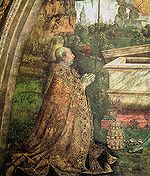Laocoön and His Sons

The statue of Laocoön and His Sons, also called the Laocoön Group (Italian: Gruppo del Laocoonte), has been one of the most famous ancient sculptures since it was excavated in Rome in 1506 and put on public display in the Vatican Museums, where it remains today. The statue is very likely the same one that was praised in the highest terms by Pliny the Elder, the main Roman writer on art. The figures in the statue are nearly life-sized, with the entire group measuring just over 2 m (6 ft 7 in) in height. The sculpture depicts the Trojan priest Laocoön and his sons Antiphantes and Thymbraeus being attacked by sea serpents.The Laocoön Group has been called "the prototypical icon of human agony" in Western art. Unlike the agony often portrayed in Christian art depicting the Passion of Jesus and martyrs, the suffering shown in this statue offers no redemptive power or reward. The agony is conveyed through the contorted expressions on the faces, particularly Laocoön's bulging eyebrows, which were noted by Guillaume-Benjamin Duchenne as physiologically impossible. These expressions are mirrored in the struggling bodies, especially Laocoön's, with every part of his body shown straining.Pliny attributed the work, then in the palace of Emperor Titus, to three Greek sculptors from the island of Rhodes: Agesander, Athenodoros, and Polydorus, but he did not mention the date or patron. In style it is considered "one of the finest examples of the Hellenistic baroque" and certainly in the Greek tradition. However, its origin is uncertain, as it is not known if it is an original work or a copy of an earlier bronze sculpture. Some believe it to be a copy of a work from the early Imperial period, while others think it to be an original work from the later period, continuing the Pergamene style of some two centuries earlier. Regardless, it was probably commissioned for a wealthy Roman's home, possibly from the Imperial family. The dates suggested for the statue range from 200 BC to the 70s AD, with a Julio-Claudian date (27 BC to 68 AD) now being the preferred option. Despite being in mostly excellent condition for an excavated sculpture, the group is missing several parts and has undergone several ancient modifications and restorations since its excavation. The statue is currently on display in the Museo Pio-Clementino, which is part of the Vatican Museums.
Excerpt from the Wikipedia article Laocoön and His Sons (License: CC BY-SA 3.0, Authors, Images).Laocoön and His Sons
Viale Oscar Romero,
Geographical coordinates (GPS) Address Nearby Places Show on map
Geographical coordinates (GPS)
| Latitude | Longitude |
|---|---|
| N 41.9042 ° | E 12.4547 ° |
Address
Musei Vaticani
Viale Oscar Romero
00120 , Vatican City
Vatican City
Open on Google Maps










